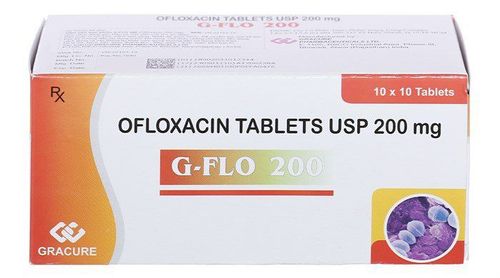This is an automatically translated article.
Sunfloxacin belongs to the group of drugs to treat infections, the main ingredient is the active ingredient Levofloxacin of the Quinolone group. The drug is indicated for the treatment of many different diseases such as acute sinusitis, pneumonia, acute bronchitis, prostatitis...
1. What is the use of Sunfloxacin?
Sunfloxacin is a medicine to treat bacterial infections with the main ingredient Levofloxacin (an antibiotic of the Quinolone group). The drug is indicated in the treatment of many bacterial infections in adults including:
Community-acquired pneumonia; Chronic bronchitis exacerbation; Acute sinusitis ; Urinary tract infections with or without complications; Prostatitis ; Skin and subcutaneous tissue infections with or without complications; Anthrax. Levofloxacin has high bactericidal properties, broad spectrum of action on both gram-positive and gram-negative bacteria, including staphylococcus, streptococcus, pneumococci, enteric bacteria, and haemophilus influenzae. It is also rapidly absorbed after entering the body, penetrating well into bone tissue, blister fluid and lung tissue, but poorly into cerebrospinal fluid. The component is very little metabolized, the amount of metabolism accounts for less than 5% of the total amount of Levofloxacin excreted in the urine.
2. Dosage, how to use Sunfloxacin
Sunfloxacin is administered by infusion. Dosage is different for each disease:
For acute bronchitis, 500mg, once a day for 7 days; For community-acquired pneumonia, 500mg, 1-2 times/day, for 7-14 days; For acute maxillary sinusitis, the dose is 500mg, once a day for 10-14 days; For infections of the skin and subcutaneous tissue with complications, the dose is 500mg, once a day for 7-10 days, without complications, the dose is 250mg, once a day for 3 days; For acute pyelonephritis - 250mg, once a day for 10 days; For anthrax use 500mg, once a day for 8 weeks, initially by intravenous infusion, then can be switched to oral drugs; For prostatitis use 500mg/24 hours, intravenous infusion, switch to oral drugs after a few days; For complicated urinary tract infections, acute pyelonephritis, creatinine clearance > 20ml/min, the initial dose is 250mg, the maintenance dose is 250mg/24 hours; Creatinine clearance from 10-19ml/min with initial dose of 250mg, maintenance dose of 250mg/48 hours; The dose does not need to be adjusted for people with liver failure, the elderly.
3. Contraindications of the drug Sunfloxacin
Sunfloxacin is contraindicated in the following cases:
People who are sensitive to Levofloxacin, Quinolone or the ingredients in the drug; Not to be used for people with epilepsy, G6PD deficiency, a history of tendon complications caused by antibiotics of the Quinolone group; Children under 18 years old, pregnant and lactating women are not eligible to use the drug.
4. Sunfloxacin side effects
Sunfloxacin may cause some side effects during treatment including:
Common: Nausea, diarrhea, increased liver enzymes, insomnia, headache, skin irritation at the injection site; Uncommon: Dizziness, anxiety, nervousness, agitation, abdominal pain, flatulence, dyspepsia, vomiting, constipation, hyperbilirubinemia, pruritus, rash; Rare: Hypertension or hypotension, cardiac arrhythmia, pseudomembranous colitis, dry mouth, gastritis, tongue edema, arthralgia, muscle weakness, myalgia, osteomyelitis, Achilles tendonitis, convulsions, sleep abnormal dreams, depression, psychosis, Quinck's edema, anaphylaxis, Stevens-Johnson and Lyell syndromes.
5. Drug interactions
Interactions can occur when taking Sunfloxacin in combination with some other drugs. Therefore, before starting to use the drug, you should tell your doctor about the drugs you are taking.
Interactions with Sunfloxacin include:
Sunfloxacin used concurrently with corticosteroids can cause inflammation and/or rupture of tendons; Concomitant use with Warfarin may cause bleeding; Concomitant use with Theophyllin may cause episodes of syncope or shock; Concomitant use with nonsteroidal anti-inflammatory drugs (NSAIDS) such as Aspirin, Ibuprofen, Fenbufen, Ketoprofen and Indomethacin may cause fainting or dizziness; Using Sunfloxacin with antiarrhythmic drugs, depression, some antipsychotics, antibiotics Erythromycin, Azithromycin and Clarithromycin can affect the heart; Concomitant use with Probenecid and Cimetidine may affect the absorption of Sunfloxacin.
6. Note when using the drug Sunfloxacin
During the use of Sunfloxacin, you should note:
Limit direct exposure to the sun because it can cause skin burns, burning, and blistering; Do not take at the same time as iron tablets, antacids or sucralfate, zinc supplements, but should be taken at least 2 hours apart; Discontinue use immediately at the appearance of serious and irreversible reactions such as tendinitis, tendon rupture, arthralgia, myalgia, peripheral neuropathy, hallucinations, anxiety, depression, loss of consciousness. sleep, severe headache and confusion; Use with caution in subjects 65 years of age and older; people taking corticosteroids; have ever had fainting or fainting, brain damage from a stroke or other brain injury; people with kidney disease; lack of glucose-6-phosphate dehydrogenase; psychosis; heart disease, liver disease, diabetes, history of myasthenia gravis; uncorrected electrolyte disturbances; congenital long QT syndrome. Above is information about uses, dosage and precautions when using Sunfloxacin. To ensure safety for your health and maximize the effectiveness of your treatment, you need to take Sunfloxacin exactly as directed by your doctor.
Please dial HOTLINE for more information or register for an appointment HERE. Download MyVinmec app to make appointments faster and to manage your bookings easily.













